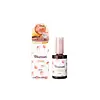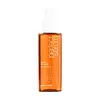What's inside
What's inside
 Key Ingredients
Key Ingredients

 Benefits
Benefits

 Concerns
Concerns

 Ingredients Side-by-side
Ingredients Side-by-side

Dimethicone
EmollientIsopropyl Myristate
EmollientDimethiconol
EmollientArgania Spinosa Kernel Oil
EmollientGamma-Docosalactone
Skin ConditioningBetula Alba Bark Extract
MaskingVinyl Dimethicone/Lauryl Dimethicone Crosspolymer
Caprylic/Capric Triglyceride
MaskingPhenoxyethanol
PreservativeWater
Skin ConditioningPrunus Persica Kernel Oil
EmollientPrunus Persica Fruit Extract
AbrasivePimpinella Anisum Fruit Water
Skin ConditioningPrunus Persica Leaf Extract
EmollientButylene Glycol
HumectantC12-14 Pareth-3
EmulsifyingParfum
MaskingDimethicone, Isopropyl Myristate, Dimethiconol, Argania Spinosa Kernel Oil, Gamma-Docosalactone, Betula Alba Bark Extract, Vinyl Dimethicone/Lauryl Dimethicone Crosspolymer, Caprylic/Capric Triglyceride, Phenoxyethanol, Water, Prunus Persica Kernel Oil, Prunus Persica Fruit Extract, Pimpinella Anisum Fruit Water, Prunus Persica Leaf Extract, Butylene Glycol, C12-14 Pareth-3, Parfum
Cyclopentasiloxane
EmollientDimethiconol
EmollientC12-15 Alkyl Benzoate
AntimicrobialParfum
MaskingArgania Spinosa Kernel Oil
EmollientSimmondsia Chinensis Seed Oil
EmollientCocos Nucifera Oil
MaskingLimonene
PerfumingPrunus Armeniaca Kernel Oil
MaskingOlea Europaea Fruit Oil
MaskingSclerocarya Birrea Seed Oil
HumectantCamellia Japonica Seed Oil
EmollientCoco-Caprylate/Caprate
EmollientLinalool
PerfumingCitronellol
PerfumingCaprylic/Capric Triglyceride
MaskingGeraniol
PerfumingCapsicum Annuum Extract
MaskingBeta-Carotene
Skin ConditioningTocopherol
AntioxidantGlycolipids
Skin ConditioningCyclopentasiloxane, Dimethiconol, C12-15 Alkyl Benzoate, Parfum, Argania Spinosa Kernel Oil, Simmondsia Chinensis Seed Oil, Cocos Nucifera Oil, Limonene, Prunus Armeniaca Kernel Oil, Olea Europaea Fruit Oil, Sclerocarya Birrea Seed Oil, Camellia Japonica Seed Oil, Coco-Caprylate/Caprate, Linalool, Citronellol, Caprylic/Capric Triglyceride, Geraniol, Capsicum Annuum Extract, Beta-Carotene, Tocopherol, Glycolipids
 Reviews
Reviews

Ingredients Explained
These ingredients are found in both products.
Ingredients higher up in an ingredient list are typically present in a larger amount.
You may know this ingredient as argan oil. Argan Oil has antioxidant, hydrating, and soothing properties.
Studies have shown argan oil can help fight again radical damage from the sun. This makes it effective at preventing hyperpigmentation.
Large amounts of vitamin E found in argan oil helps the skin retain water. Argan oil also contains fatty acids such as linoleic acid, oleic acid, and palmitic acid. It is also a good source of lipids.
Another benefit of argan oil is skin-soothing. It can help reduce inflammation-related skin symptoms.
Argan Oil is effective at regulating sebum production in pores. This can make it effective at treating hormonal acne.
Traditionally, argan oil was used for its antibacterial and antifungal properties. However, argan oil contains fatty acids that may make it not fungal-acne safe.
Argan Trees are native to Morocco.
Learn more about Argania Spinosa Kernel OilThis ingredient is an emollient, solvent, and texture enhancer. It is considered a skin-softener by helping the skin prevent moisture loss.
It helps thicken a product's formula and makes it easier to spread by dissolving clumping compounds.
Caprylic Triglyceride is made by combining glycerin with coconut oil, forming a clear liquid.
While there is an assumption Caprylic Triglyceride can clog pores due to it being derived from coconut oil, there is no research supporting this.
Learn more about Caprylic/Capric TriglycerideDimethiconol is a silicone that resembles the popular dimethicone. Like other silicones, it is an emollient. Emollients create a thin film on skin to prevent moisture from escaping.
This ingredient helps to create a silky texture and improve spreadability. Due to its high molecular weight and thickness, it is often combined with cyclopentasiloxane.
Parfum is a catch-all term for an ingredient or more that is used to give a scent to products.
Also called "fragrance", this ingredient can be a blend of hundreds of chemicals or plant oils. This means every product with "fragrance" or "parfum" in the ingredients list is a different mixture.
For instance, Habanolide is a proprietary trade name for a specific aroma chemical. When used as a fragrance ingredient in cosmetics, most aroma chemicals fall under the broad labeling category of “FRAGRANCE” or “PARFUM” according to EU and US regulations.
The term 'parfum' or 'fragrance' is not regulated in many countries. In many cases, it is up to the brand to define this term.
For instance, many brands choose to label themselves as "fragrance-free" because they are not using synthetic fragrances. However, their products may still contain ingredients such as essential oils that are considered a fragrance by INCI standards.
One example is Calendula flower extract. Calendula is an essential oil that still imparts a scent or 'fragrance'.
Depending on the blend, the ingredients in the mixture can cause allergies and sensitivities on the skin. Some ingredients that are known EU allergens include linalool and citronellol.
Parfum can also be used to mask or cover an unpleasant scent.
The bottom line is: not all fragrances/parfum/ingredients are created equally. If you are worried about fragrances, we recommend taking a closer look at an ingredient. And of course, we always recommend speaking with a professional.
Learn more about Parfum